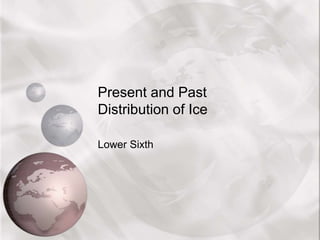
Past and Present Distribution of Ice
- 1. Present and Past Distribution of Ice Lower Sixth
- 2. What we’ll Learn today 1. That ice distribution was not uniform 2. That ice comes in various types of mass 3. That various glaciers exist 4. Ice is often constrained by several factors
- 3. Present and Past Distribution of Ice • Glaciers are a very sensitive and visible barometer of climate change as they constantly shrink/retreat and grow/advance in responses to changes in temperature Cryosphere – Parts of the earths crust and atmosphere subject to temperatures below 0oC for some part of the year.
- 4. Types of Ice Masses • Ice can be classified into different characteristics such as size and location: Types of Ice Mass Description Size (sq km) Ice sheet a layer of ice covering an extensive tract of land for a long period of time. 10 – 100,000 Ice cap miniature ice sheets. form primarily in polar and sub-polar regions that are relatively flat and high in elevation 3 – 10,000 Ice field A large expanse of ice covering a mountainous region and consisting of several interconnected glaciers 10 – 10,000 Valley Glacier Glacier confined by valley walls 3 – 1500 Piedmont Glacier occur when steep valley glaciers flow onto relatively flat plains, where they spread out into fan or bulb shapes (lobes). 3 – 1000 Cirque Glacier are named for the bowl-like hollows they occupy, which are called cirques 0.5 – 8 Ice shelf floating sheet of ice permanently attached to a land mass 10 – 10,000
- 5. Glacier Types • Some glaciers are land based such as those on the Alps (e.g. Mer De Glace) • Others are marine based – base is below sea level (e.g. west Antarctic ice sheet)
- 6. Constraint • Some marine based ones can go 2000m below sea level and be frozen directly to the seabed • A further morphological contrast is provided from the degree of constraint. • Unconstrained glaciers – tend to be larger forms such as ice sheets and ice caps • These are thick and extensive and often submerge the landscape • Constrained – those that have a physical; limit such as valley glaciers where the landscape constrains where they are and tend to only drain one way
- 7. 2 Types of Glacier • Warm based • Temperate or wet glaciers occur at high altitude areas outside of polar regions • Temperatures fluctuate on the surface to above and below freezing • The rest below the surface is close to melting point because the pressure builds up. • Because of this water exists as a liquid at temperatures below 0 degrees
- 8. Warm Based • Having liquid at the bottom causes them to melt continually (Basal ice – ice at bottom of glacier) • The ice also has lots of debris at the bottom also and this creates many subglacial deposits and landforms
- 9. Cold Based Glacier • Polar glaciers where average temperature is often below 0 degrees with surface temperatures of -20 to -30 degrees • Therefore the temperature at the base is still below freezing even though the ice could be 500m thick • Limited surface melt during the polar summer and so the glacier is permanently frozen to the bed • The basal layer therefore has far less debris within it.
- 10. Geothermal Gradients of glacier types
- 11. Polythermal Glacier • This is a glacier which is warm based but the margin cold based • The upper zone is cold based whilst the lower zone is warm based • Due to extending into warmer climate zones • An example of this is some of the glaciers on Svalbard
- 13. Surging Glaciers • These can occur within warm based or polythermal glaciers • The glacier begins to flow at up to 100m a day • Greenland outer glaciers can do this (30m per day) • This leads to increased calving
- 14. Past and Present Ice distribution • Glacial ice covers over 10% of the earth’s land surface • It accounts for 75% of all freshwater stores • 1.8% of all water on the planet
- 15. Where is it? • 85% of all glacier ice is contained within the Antarctica ice (Both west and East ice sheets) • The rest is distributed amongst ice caps all over the world: • Iceland • Canada • USA • Himalayas • Andes • Alps
- 16. • Glacier exist in the • High Andes • Tanzania • Indonesia • Even though these are equatorial due to the height • The two most important factors governing where they are is • Latitude - For polar ice caps • Altitude - For Alpine glaciers
- 17. Why? • At high altitudes the suns rays hit at a lower angle so the solar energy received has to heat a larger area • High altitude impacts on temperature via the Environmental Lapse Rate (The rate at which temperature decreases with altitude at a given time) • This is approximately 1% for every 100m
- 18. Local Factors • Aspect – This determines the amount of snow that settles. • Relief and aspect in mountainous areas combine to affect where cirques form • Northern Hemisphere • North and East slopes are more sheltered and receive less sun therefore better able to hold snow (Hence North Face)
- 19. Past Cover • During the Pleistocene maximum ice cover was around 3 times what it is today • The Antarctica and Greenland ice sheets only covered a slightly greater amount than they do today • The major extensions could be found • North America (Laurentide and Cordilleran ice sheets) • Scandinavian Ice sheet in Europe • Both these grew to a thickness of 3000-4000m and transformed the landscape • Other significant areas included S. America, New Zealand, Siberia and the Himalayas.
